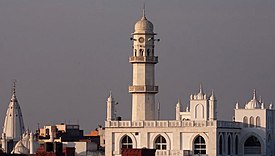world.wikisort.org - India
Gurdaspur is a city in the Indian state of Punjab, between the rivers Beas and Ravi. It houses the administrative headquarters of Gurdaspur District and is in the geographical centre of the district, which shares a border with Pakistan. The Emperor Akbar was crowned at Kalanaur, which is 26 km from the city.[2]
This article possibly contains original research. (May 2021) |
Gurdaspur | |
|---|---|
City | |
 Gurdaspur  Gurdaspur | |
| Coordinates: 32.0333°N 75.40°E | |
| Country | |
| State | Punjab |
| District | Gurdaspur |
| Region | Majha |
| Government | |
| • Type | Municipality |
| • Body | Municipal Council Gurdaspur |
| • Member of the Legislative Assembly | Barindermeet Singh Pahra |
| • Member of Parliament | Sunny Deol |
| • Deputy Commissioner | Mohammad Ishfaq, IAS[1] |
| Area | |
| • City | 45 km2 (17 sq mi) |
| • Rank | 5th |
| Elevation | 241 m (791 ft) |
| Population (2015) | |
| • City | 120,564 |
| • Density | 649/km2 (1,680/sq mi) |
| • Metro | 744,092 |
| Time zone | UTC+5:30 (IST) |
| PIN | 143521 |
| Area code | +91-1874-XXX XXXX |
| Vehicle registration | PB-06, PB-18, PB-58, PB-99, PB-85 |
| Website | gurdaspur |
History
Mughal period
Gurdaspur was founded by a dervish ('Muslim ascetic') named Bhai Chand.[3] In April 1715, the Sikh revolutionary leader Banda Bahadur seized Gurdaspur from the Mughal forces of Farrukhsiyar (r. 1713–1719).[3] Banda strengthened his defences, increased storage of supplies, and slashed the shahnahr canal.[3] After an eight-month siege, the Mughal army of Abd al-Samad Khan broke into the Sikh garrison, arrested Banda and conquered Gurdaspur in December 1715.[4]
Demographics
According to the 2011 India census,[6] Gurdaspur had a population of 2,299,026 (1,212,995 males and 1,086,031 females). There was a 9.30% increase in population compared to that of 2001. In the previous 2001 census of India, Gurdaspur District had recorded a 19.74% increase to its population compared to 1991. According to religion, Sikhs made up 68.9% of the city's population, with Hindus making up 24.8%.[7]
The average literacy rate of Gurdaspur in 2011 was 81.10%, compared to 73.80% in 2001. The male and female literacy rates were 85.90% and 75.70%, respectively. For the 2001 census, the rates were 79.80% and 67.10% respectively. The total literate population was 1,668,339, consisting of 928,264 males and 740,075 females. Sex ratio is about 895 females per 1000 males. Population Density was 649 per square km. [6]
Politics
The city is part of the Gurudaspur Assembly Constituency and Gurdaspur (Lok Sabha constituency).
Education
Gurdaspur has many elementary and secondary level schools and has 13 degree level and engineering colleges.[8] Beant College of Engineering and Technology, is among them, founded by then Chief Minister Beant Singh in 1995. A nationally accredited body by the Ministry of Tourism Institute of Hotel Management, Catering & Nutrition is also located in Gurdaspur.
Colleges
- Beant College of Engineering and Technology
Administrative towns
- Batala
- Qadian
- Kalanaur
- Sri Hargobindpur
- Dera Baba Nanak
- Dhariwal
- Dinanagar
- Fatehgarh Churian
See also
- Bathwala
- Ranjit Bagh
References
- "Punjab Police Amritsar". gurdaspur.nic.in. Retrieved 3 March 2020.
- "About District". Gurdaspur.nic.in. Archived from the original on 2 August 2005. Retrieved 4 March 2013.
- Irvine 1904, p. 312.
- Irvine 1904, p. 315.
- "Gurdaspur City Population - Gurdaspur, Punjab". Retrieved 2 December 2021.
- "Gurdaspur District Population Census 2011, Punjab literacy sex ratio and density". Census2011.co.in.
- "Gurdaspur City Population - Gurdaspur, Punjab". Censusindia2011.com. Retrieved 3 December 2021.
- "Education Facilities in District Gurdaspur". Gurdaspur.nic.in. Archived from the original on 18 May 2005. Retrieved 31 March 2013.
Further reading
- Chester, Lucy P. Borders and Conflict in South Asia: The Radcliffe Boundary Commission and the Partition of Punjab. Manchester UP, 2009.
- Chisholm, Hugh, ed. (1911). . Encyclopædia Britannica. Vol. 12 (11th ed.). Cambridge University Press.
- Official website
- Irvine, William (1904), The Later Mughals, Low Price Publications, ISBN 81-7536-406-8
На других языках
[de] Gurdaspur
Gurdaspur (Punjabi: ਗੁਰਦਾਸਪੁਰ) ist eine Stadt (Municipal Council) im indischen Bundesstaat Punjab.- [en] Gurdaspur
[ru] Гурдаспур
Гурдаспур (англ. Gurdaspur, в.-пандж. ਗੁਰਦਾਸਪੁਰ) — город в северной части штата Пенджаб, Индия. Административный центр округа Гурдаспур.Другой контент может иметь иную лицензию. Перед использованием материалов сайта WikiSort.org внимательно изучите правила лицензирования конкретных элементов наполнения сайта.
WikiSort.org - проект по пересортировке и дополнению контента Википедии



